The Wheelchair Guide
Your Wheelchair and Mobility Scooter Resource
A Look at Manual and Electric Wheelchairs
Tuesday, March 9th, 2010
The wheelchair is probably the most recognized type of mobility vehicle, with its invention being traced back over a thousand years. However, if you were to look at one of the wheelchairs used by people during the 1600′s and compare it to one of those used today, you would be hard pressed to find similarities, aside from both having wheels and their general function.
Manual Wheelchairs
 Today, wheelchairs are either manually powered or electric powered. Manual wheelchairs, or self-propelled wheelchairs, remain very popular and are often the least expensive option. Of course, there are exceptions to this rule, but generally a manual wheelchair costs about a third of what an electric wheelchair would.
Today, wheelchairs are either manually powered or electric powered. Manual wheelchairs, or self-propelled wheelchairs, remain very popular and are often the least expensive option. Of course, there are exceptions to this rule, but generally a manual wheelchair costs about a third of what an electric wheelchair would.
The general design of a manual wheelchair is based off of the 1920′s E&J Wheelchair Frame, which was a folding hollow-tubed wheelchair, designed to be easily transported. The basic design has not changed too much and the outline of the E&J wheelchair can still be seen in most modern wheelchair.
Most manual wheelchairs have a a large set of rear wheels, which can be turned by the person sitting in the wheelchair. A metal hand-rim extends from the rear wheel, providing a handhold for the user to grasp and spin the wheel, without having to touch the part that makes contact with the ground. The front wheels are usually much smaller and the front rigging of the wheelchair provides a footrest for the user, so their feet do not touch the ground.
The seat of a standard manual wheelchair is often made out of vinyl, which is looped around the metal tube framing of the wheelchair and sewn in place. However, more breathable fabrics are also available and are more common on sports wheelchairs. When not in use, the wheelchair can be folded up, making it much easier to transport.
While the majority of manual wheelchairs are self propelled, transport wheelchairs are also available, which are designed to be pushed from behind. Transport wheelchairs share a similar design, but the rear wheels are usually smaller and do not have handrims.
Electric Wheelchairs
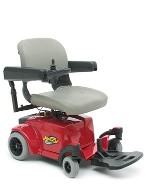 Electric wheelchairs are becoming much more common and offer the same basic functionality of a manual wheelchair, but the chair itself is powered by an electric motor, instead of the wheelchair user. The seat, which varies in size, but often resembles an office chair, is mounted atop a plastic base. The plastic base contains the electric motor and rechargeable battery that powers the wheelchair.
Electric wheelchairs are becoming much more common and offer the same basic functionality of a manual wheelchair, but the chair itself is powered by an electric motor, instead of the wheelchair user. The seat, which varies in size, but often resembles an office chair, is mounted atop a plastic base. The plastic base contains the electric motor and rechargeable battery that powers the wheelchair.
Like a manual wheelchair, electric wheelchairs provide a footrest, but the footrest is usually one piece of plastic, instead of the two individual footrests that are most common on a manual wheelchair. The standard control system for an electric wheelchair is a single joystick control that is mounted to the left or right armrest. The control system allows the wheelchair to be turned and moved by pushing on the joystick, as well as offering buttons to control the speed of the wheelchair. The range can vary depending on the model, as does the speed, but most quality electric wheelchairs can travel around 10 miles per charge and up to 4MPH.
Which is Better? Electric or Manual?
This is something that varies greatly by user and a lot of it comes down to personal preference. However, using a manual wheelchair can be quite strenuous, requiring a good deal of upper body strength, so this is often a factor. Cost also often plays a role, with many quality manual wheelchairs being available for under $500, while most electric wheelchairs cost over $2000.
Another factor to consider is where the wheelchair is going to be used and how often it will be used. A manual wheelchair may end up being easier to transport and better suited for indoor use, while for those who will be traveling across greater distances each day, an electric wheelchair might be a better choice.
Electric Wheelchair Buyers Guide and FAQ
Tuesday, February 2nd, 2010
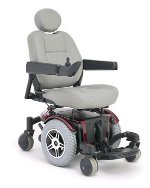 The wheelchair is one of the oldest known mobility aids, greatly improving the lives of those who have difficulty walking. There are many types of wheelchairs available, with sports wheelchairs becoming much more popular over the last ten years. However, for many the choice is whether to buy an electric wheelchair or a manual wheelchair, with both offering their own advantages.
The wheelchair is one of the oldest known mobility aids, greatly improving the lives of those who have difficulty walking. There are many types of wheelchairs available, with sports wheelchairs becoming much more popular over the last ten years. However, for many the choice is whether to buy an electric wheelchair or a manual wheelchair, with both offering their own advantages.
This guide provides the answers to some frequently asked questions about electric wheelchairs, which will help the consumer make an informed purchasing decision.
Electric wheelchairs, which are often called power chairs, are quite popular, but with so many choices and models available, it is important to understand how electric wheelchairs work and what their features are, before submitting to a high pressure sales pitch from your local medical supply store or online dealer.
Table of Contents
- What is an Electric Wheelchair?
- Electric Wheelchairs vs Manual Wheelchairs
- Where Can I Use An Electric Wheelchair?
- What is the Difference Between Mid-Wheel and Rear-Wheel Drive Power Chairs?
- How Are Power Chairs Controlled?
- Are There Any Alternate Control Systems Available for Power Chairs?
- How is the Chair Different Than a Manual Wheelchair?
- What Type of Range and Speed Should I Expect?
- How Do I Transport An Electric Wheelchair?
- What Are Travel Power Chairs?
- What Are Some Popular Power Chair Manufacturers?
What is an Electric Wheelchair?
An electric wheelchair is a motorized wheelchair that is powered using one or more rechargeable batteries. This allows the electric wheelchair, which is often referred to as a power chair, to be used easily away from the home, over both indoor and outdoor terrain.
The first electric wheelchairs, which were developed during the 1950′s, were simply manual wheelchairs that were outfitted with an electric motor, but today, they are custom made.
Electric Wheelchairs vs Manual Wheelchairs
Choosing between a manual wheelchair or an electric wheelchair is often a very personal decision, as they both offer advantages and disadvantages. In many cases, this comes down to personal preference, but there are several important things that should be considered when deciding whether to buy a power chair or a manual wheelchair.
The main advantage of an electric wheelchair is that it requires very little effort to use, while using a manual wheelchair is very strenuous. Where manual wheelchairs require that the user be pushed or self propel, with the latter requiring a great deal of upper-body strength, an electric wheelchair can be controlled with very little effort on the part of the user.
However, one disadvantage of electric wheelchairs is that they are much heavier and more difficult to transport than manual wheelchairs, which will be discussed later in the how do I transport an electric wheelchair section. Another consideration is that manual wheelchairs usually cost significantly less than power chairs.
Where Can I Use An Electric Wheelchair?
Like Mobility Scooters, electric wheelchairs are designed to be used both indoors and outdoors. However, they preform best over tightly packed surfaces. Due to their design, they are also not as well suited for outdoor travel as a mobility scooter is though, usually with a much shorter wheelbase and sometimes smaller wheels, making them work best over concrete or other hard surfaces.
However, unlike mobility scooters, an electric wheelchair can be driven directly up to a table or desk, in the same way that a manual wheelchair can.
What is the Difference Between Mid-Wheel and Rear-Wheel Drive Power Chairs?
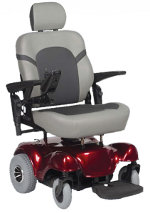 Rear-Wheel Drive Power Chairs typically have four wheels, which are spaced evenly apart from one another. The set of wheels in the back, the rear wheels, are what actually moves the power chair.
Rear-Wheel Drive Power Chairs typically have four wheels, which are spaced evenly apart from one another. The set of wheels in the back, the rear wheels, are what actually moves the power chair.
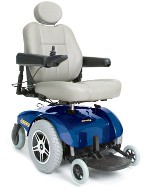 Mid-Wheel Drive Power Chairs, on the other hand, usually have three sets of wheels. The set of wheels in the middle is positioned directly under the seat and the front and back set of wheels are positioned about the same as those on a Rear-Wheel Drive chair. However, it is the middle set of wheels that moves the wheelchair, with the front and back set of wheels providing support and stability.
Mid-Wheel Drive Power Chairs, on the other hand, usually have three sets of wheels. The set of wheels in the middle is positioned directly under the seat and the front and back set of wheels are positioned about the same as those on a Rear-Wheel Drive chair. However, it is the middle set of wheels that moves the wheelchair, with the front and back set of wheels providing support and stability.
The main advantage of a mid-wheel drive wheelchair is that it is more maneuverable than a rear wheel drive wheelchair. Like manual wheelchairs, electric wheelchairs are steered by moving one wheel, while holding the other still. A Mid-Wheel Power Chair allows for a much smaller turning radius, as the turning axis is directly below the wheelchairs seat.
In contrast, a rear-wheel drive wheelchair turns from the back, as this is where the drive wheels are, which means it will have a higher turning radius. However, because the weight of the rider is more evenly distributed between the front and back of the wheelchair, a rear wheel drive wheelchair is typically more stable and better able to support larger weights. To counteract this, some mid-wheel drive wheelchairs are considerably larger and include support wheels that are positioned further from the frame than normal.
How Are Power Chairs Controlled?
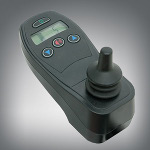 The basic control system that was first developed during the nineteen-fifties is still used today, with a joystick control being the standard control system for most electric wheelchairs. Of course, it is electronically based and made using much better technology, but the concept remains the same.
The basic control system that was first developed during the nineteen-fifties is still used today, with a joystick control being the standard control system for most electric wheelchairs. Of course, it is electronically based and made using much better technology, but the concept remains the same.
Typically, the joystick is mounted to the armrest on either side of the wheelchair, with most models also including simple throttle and horn controls as well.
Are There Any Alternate Control Systems Available for Power Chairs?
For those who are unable to use the traditional joystick control, a number of alternate wheelchair controls have been developed, with many of these having roots in the first wheelchair systems. Power chair control systems that allow the head to control the wheelchair are one of the more common, with several available that allow the wheelchair to be controlled by head movements.
Another popular option allows the users breath to control the movements of the wheelchair, with the user blowing through a small tube, similar to a straw, to move the wheelchair. There are also a number of experimental controls being developed, with one of the most promising allowing the user to control the wheelchair with their tongue, as it is common for movement of the tongue to remain, even in those who are otherwise paralyzed.
There are also a number of control systems developed with the caretaker in mind, which include remote control systems that allow the wheelchair to be controlled by someone walking behind it.
Also in development, there are several systems that allow the wheelchair to learn an environment, either by using GPS to map the environment or by manually adding map. This allows the wheelchair to navigate a room, building, or even campus, using proximity sensors to detect objects in the way. While still currently being developed, there are several live studies of these types of chairs, including one at a nursing home. Other potential controls, which could revolutionize wheelchair movements, include eye tracking software, which is able to detect where a user is looking.
How is the Chair Different Than a Manual Wheelchair?
The seat on most manual wheelchairs is made of vinyl, which is sewn around the frame of the wheelchair, although more breathable materials are also popular, especially on sports wheelchairs. However, the seat of an electric wheelchair more closely resembles a office chair. Some include a high back, with neck rest, while others have a much lower back, but they are typically made in a similar process, with a cushion built atop a hard flat board.
Depending on the model, some power chairs even have a reclining backrest and most allow the seat to be pivoted in both directions, making it easier to transport into and out of the chair.
If you buy a standard power chair, such as those made by Pride Mobility or Golden Technologies, there aren’t really too many options when it comes to the seat. However, special rehab seats are available, which include more supportive headrests, improved cushioning, and fully reclining seats. These power chairs also include individual leg rests that more closely resemble the leg rests used on a manual wheelchair, instead of the single platform that is usually provided for standard power chairs.
 Pride Mobility’s Quantum Rehab division is one of the more well known offers of specialized power chairs, with bariatric and pediatric seats available that are mounted to one of their standard power chair bases. These seats also used a much more ergonomic cushioning that provides improved back support, as well as power tilt, which allows the seat to be reclined electronically.
Pride Mobility’s Quantum Rehab division is one of the more well known offers of specialized power chairs, with bariatric and pediatric seats available that are mounted to one of their standard power chair bases. These seats also used a much more ergonomic cushioning that provides improved back support, as well as power tilt, which allows the seat to be reclined electronically.
Back to Top
What Type of Range and Speed Should I Expect?
This varies depending on the model of scooter, as well as how it is used. However, most travel at speeds of between 3 and 4mph, with a range of around 15 miles.
One thing to keep in mind is that the range and speed is affected by the weight of the rider, as well as the terrain being traveled over. For example, if traveling uphill, the wheelchair’s battery will wear out faster and the chair itself will move slower than when traveling across flat ground.
Also, the battery will need to be replaced periodically, with the wheelchair loosing performance and range as the battery wears down.
How Do I Transport An Electric Wheelchair?
 Electric wheelchairs are much heavier than manual wheelchairs and can not be folded up and placed in the trunk the same way you would with a self-propelled wheelchair. While most electric wheelchairs are designed to be taken apart, the individual pieces can be rather heavy and bulky. As a result, those who intend to use the wheelchair away from home, usually need to buy a wheelchair lift or a wheelchair ramp for their vehicle.
Electric wheelchairs are much heavier than manual wheelchairs and can not be folded up and placed in the trunk the same way you would with a self-propelled wheelchair. While most electric wheelchairs are designed to be taken apart, the individual pieces can be rather heavy and bulky. As a result, those who intend to use the wheelchair away from home, usually need to buy a wheelchair lift or a wheelchair ramp for their vehicle.
The least expensive option is the wheelchair ramp, with several foldable metal ramps available. These allow the wheelchair to be driven directly into a van, but do not work as well with other vehicles. Often, these ramps are not actually secured to the van itself, but there are also some van ramps available that are bolted to the floor of the van and can be folded down into place, making it much easier to use independently.
Wheelchair lifts are another option and offer much more flexibility, as they can be used on cars, trucks, SUVs, and Vans. Wheelchair lifts either act as a lifting platform, sort of like an elevator, or as a crane. They are also classified as either internal wheelchair lifts or external wheelchair lifts.
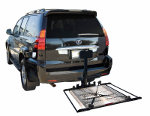 External Wheelchair Lifts are mounted to the hitch of a vehicle and typically store the wheelchair outside on the back end of the vehicle. However, there are several hitch mounted crane lifts that are used to move the wheelchair into inside of the vehicle.
External Wheelchair Lifts are mounted to the hitch of a vehicle and typically store the wheelchair outside on the back end of the vehicle. However, there are several hitch mounted crane lifts that are used to move the wheelchair into inside of the vehicle.
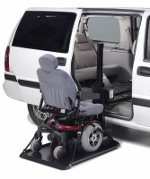 Internal Wheelchair Lifts, on the other hand, store the wheelchair on the inside of the vehicle. These work by either extending a platform from the vehicle onto the ground or by using the crane method. In vans, the platform lift works well when it is installed behind the drivers seat, with the mid row seating of the van removed. However, they can also be used on TRUCKS and SUVS. For passenger cars, a crane lift is usually the only option.
Internal Wheelchair Lifts, on the other hand, store the wheelchair on the inside of the vehicle. These work by either extending a platform from the vehicle onto the ground or by using the crane method. In vans, the platform lift works well when it is installed behind the drivers seat, with the mid row seating of the van removed. However, they can also be used on TRUCKS and SUVS. For passenger cars, a crane lift is usually the only option.
Wheelchair lifts are either powered by a rechargeable battery pack or by directly connecting to the vehicles battery. While wheelchair lifts that are connected to the vehicles battery are sometimes a little more complicated to set up, they end up being much lower maintenance, as you do not need to remember to charge the battery pack. Some wheelchair lifts also allow the wheelchairs charger to be plugged into it, so the wheelchair can be charged while on the road.
What Are Travel Power Chairs?
Travel Power Chairs are electric wheelchairs that are designed to be as lightweight as possible, which can make it easier to travel with them. They are usually designed to be taken apart easily, with the individual pieces being lighter and easier to manage. Also sometimes called portable power chairs, these wheelchairs can sometimes be transported without having to use a wheelchair lift.
However, this comes at the expense of features and range, as the wheelchair is stripped of as much weight as possible. This means a much smaller seat, with less padding, as well as a shorter range and weight capacity.
Folding Power Chairs are also available, which look similar to a manual wheelchair and can be folded in the same way. While these do take up less space than a standard power chair, they are still quite heavy, so are not often the best choice.
What Are Some Popular Power Chair Manufacturers?
Probably the most well known power chair manufactures are Pride Mobility and Golden Technologies, with both companies offering a number of popular and reliable electric wheelchairs. Pride’s Quantum Rehab line is also very popular, as they offer a number of wheelchairs with improved seating and controls, designed with rehab in mind.
While Pride Power Chairs and Golden Power Chairs are the most well known, there are many other manufacturers, with ShopRider Wheelchairs gaining popularity in the past few years by offering a lower price alternative.
When shopping for an electric wheelchair, however, it is important to not only focus on the price of the wheelchair and instead read reviews and consumer reports for each brand, while avoiding the many cheap no-name wheelchairs available. It is also important to make sure the company offers a comprehensive warranty.
Electric Power Wheelchairs: An Introduction
Wednesday, April 29th, 2009
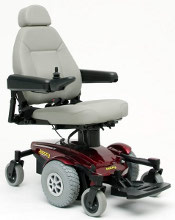 The electric wheelchair is today very popular and has been around since the early 1950′s. Early electric wheelchairs simply used the frame of a manual wheelchair and added an electric motor to it. Unlike manual wheelchairs, which require a great deal of upper body strength to use, electric wheelchairs require virtually no effort on the part of the user. They are also often referred to as power chairs or electric power chairs.
The electric wheelchair is today very popular and has been around since the early 1950′s. Early electric wheelchairs simply used the frame of a manual wheelchair and added an electric motor to it. Unlike manual wheelchairs, which require a great deal of upper body strength to use, electric wheelchairs require virtually no effort on the part of the user. They are also often referred to as power chairs or electric power chairs.
Today, some models are still available that use a traditional manual wheelchair design, but most make use of a molded plastic base, which contains the electric motor. One or more batteries is also contained in the base of the electric wheelchair, which allows it to be used over great distances.
The range and top speed of an electric wheelchair varies by model, but most are able to at least travel 5 miles on a single charge and at speeds of around 4 mph. The weight capacity of electric wheelchairs varies by model, but 250 pounds is almost an industry standard.
The chair of the electric wheelchair in some regards resembles an office chair, with a high back and armrests on either side. It includes a good deal of padding and can be reclined. It also usually swivels to the left or right, allowing for the power chair to be exited in a safe manner. The chair, which is often called the Captain’s Chair, usually has foldable armrests to further facilitate smooth transfers into and out of the chair. Some even have an electrical lifting system, which raises and lowers the chair. This can be important if, for example, using a table that is higher than normal.
Electric Wheelchair Control Systems
Most power chairs use a joystick control that is mounted to the armrest of the chair. This design is the same used on the first electric wheelchairs and can be configured for use on the left or right side of the power chair. There are also a number of alternate controls available for those who are not able to operate the joystick.
Perhaps the most common alternate wheelchair control allows the wheelchair to be controlled by the users breath. Blowing into the wheelchair moves it forward and breathing in moves it backwards. The direction of the wheelchair can also be controlled. There are a number of other alternate controls, including a remote control that can be operated by a caretaker.
Portable Power Chairs
 If you want to transport a traditional power chair, it is usually necessary to use a wheelchair lift. However, portable power chairs are available, which are lightweight and can be folded to take up less space. These models closely resemble a manual wheelchair, with a steel or aluminum frame and cloth seat. However, they still weigh a great deal more than a manual wheelchair would.
If you want to transport a traditional power chair, it is usually necessary to use a wheelchair lift. However, portable power chairs are available, which are lightweight and can be folded to take up less space. These models closely resemble a manual wheelchair, with a steel or aluminum frame and cloth seat. However, they still weigh a great deal more than a manual wheelchair would.
The motor and battery is installed under the seat and while these units often do not have as far of a range as other power chairs, they are easier to transport.
Wheelchair Controls and BCI
Monday, November 10th, 2008
The first electric wheelchair was invented in the fifties. This chair made use of a simple control stick that could be mounted to either side of the chair. This allowed the chairs occupant to control the movement of the wheelchair using little more than a finger. This control setup is still very common, but, as the inventors in the fifties quickly realized, many people cannot use the joystick system.
Alternative control methods were developed almost as soon as the electric wheelchair was created. Several different control schemes were created, but the most common utilized head movement to control the wheelchairs.
There are many different control setups that are used today, including several that utilize head movements. One of the most common types of alternate wheelchair control uses the breath of the user to control the chair. The occupant will blow or suck through a small straw, which controls the wheelchair.
Several different wheelchair control systems are currently in the development stage, which use computers to control the chair. One uses voice recognition software to control the chair, while another uses a small magnet that is stuck to the riders tongue. A special headset picks up the movements of the magnet and sends them to a computer.
Recently, thought controlled computers have begun to be experimented with. This is commonly referred to as a brain-computer interface (BCI.) The development of a BCI actually began in the seventies, but it wasn’t until the middle of the nineties that an actual working prototype was built.
A brain-computer interface offers two different services. It can allow an individual to interact with a computer or it can be used to help trigger nerves and possible facilitate movement. In the terms of wheelchair control, the ability to interact with the computer is of most importance, but being able to have the computer signal back if there is an object in the way, could also be extremely beneficial.
In regards to wheelchairs, this technology offers many exciting applications. Computer controlled wheelchairs are currently available and being developed. These machines can be for the most part completely controlled by a laptop, so using BCI, an individual will eventually be able to control their wheelchair with only a thought.
There are two main types of Brain Controlled Interfaces: Invasive and non-invasive. Invasive BCI, involves physically implanting an electrode into the brain. These offer the clearest signal, but pose a health risk, as sometimes the area will scar or weaken. There are also a less invasive version that implants electrodes into the head, but not into the brain. This improves signal, but reduces the risk of irritating the brain.
Non-invasive BCIs are more common today. A user will wear a piece of headgear that is covered in electrodes. The signal is weaker, but it is currently safer to use in this manner.
Brain Controlled Computers will likely play a big part in rehabilitation treatment in the future. Several studies and commercial ventures are currently taking part in research and development of BCI. There are several systems available that allow a user to control a computer with their mind and thereby allowing them to speak and communicate their thoughts.